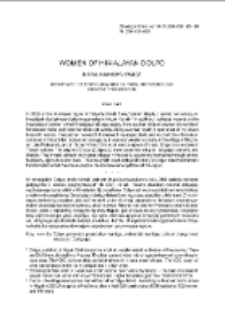- Search in all Repository
- Literature and maps
- Archeology
- Mills database
- Natural sciences
Advanced search
Advanced search
Advanced search
Advanced search
Advanced search

Object
Title: Women of Himalayan Dolpo
Subtitle:
Ethnologia Polona 29-30 (2008-2009)
Publisher:
Institute of Archaeology and Ethnology Polish Academy of Sciences
Place of publishing:
Description:
Type of object:
Abstract:
In 2008, in the Himalayan region of Dolpo1 (Karnali Zone, Western Nepal), I carried out a study on the subject of pilgrims and pilgrimage routes to Mount Kailash.2 In addition, I collected material on the lives today of women in the Himalayas. In Dolpo society, there is a clear division between the worlds of females and males, and these worlds do not overlap. Being a woman myself, I spent most of my leisure time with women. I focused on “women’s” themes with my respondents, and much of the information contained in this article I received while engaging in open conversations, mostly in the village of Ringmo on Lake Phoksundo, and in Dunai.3 One of the most remote regions of Nepal, Dolpo is an enclave of Tibetan culture. The people of Dolpo (Dolpo-pa) share a common religion, language, customs, and lifestyle. They inhabit some of the highest villages in the world, supporting themselves through animal husbandry, agriculture and trade. The ethnographic and ecological history of Dolpo trace the dramatic transformations that have taken place in the socioeconomic patterns of the region
References:
Bauer Kenneth M., 2004, High frontiers: Dolpo and the changing world of Himalayan pastoralists, Colambia University Press, New York
Goldstein Melvyn C., 1971, Stratification, Polyandry, and Family Structure in Central Tibet, Southwestern Journal of Anthropology, 27(1), pp. 64–74
Goldstein Melvyn C., 1987, When Brothers Share a Wife, Natural History, 96(3), pp. 109–112
Gumińska Barbara, Wojewoda Władysław, 1988, Grzyby i ich oznaczanie, PWRiL Warszawa
Jiao Ben, 2001, Socio-economic and Cultural Factors Underlying the Contemporary Revival of Fraternal Polyandry in Tibet. Cleveland
Kind Marietta, 2003, Tapriza Lobtra – A Community Based Culture School and its history, International Conference on Development Assistance to Ethnic Tibetan Communities, Mongolian and Tibetan Affairs Commission Taipei, pp. 24–38
Szynkiewicz Sławoj, 1992, Pokrewieństwo, UW, Warszawa
Valli Eric, Summers Diane, 1988, Dolpo: hidden land of the Himalayas, Aperture, Michigan
Relation:
Volume:
Start page:
End page:
Detailed Resource Type:
Format:
Resource Identifier:
oai:rcin.org.pl:61480 ; 0137-4079
Source:
IAiE PAN, call no. P 366 ; IAiE PAN, call no. P 367 ; IAiE PAN, call no. P 368 ; click here to follow the link
Language:
Digitizing institution:
Institute of Archaeology and Ethnology of the Polish Academy of Sciences
Original in:
Library of the Institute of Archaeology and Ethnology of the Polish Academy of Sciences
Access:
Object collections:
- Digital Repository of Scientific Institutes > Partners' collections > Institute of Archeology and Ethnology PAS > Institute Publications
- Digital Repository of Scientific Institutes > Partners' collections > Institute of Archeology and Ethnology PAS > Institute Publications > Current Journals
- Digital Repository of Scientific Institutes > Literature > Journals/Articles
- Digital Repository of Scientific Institutes > Partners' collections > Institute of Archeology and Ethnology PAS > Institute Publications > Current Journals > Ethnologia Polona
Last modified:
Feb 2, 2022
In our library since:
Jan 10, 2017
Number of object content downloads / hits:
28
All available object's versions:
https://rcin.org.pl./publication/76199
Show description in RDF format:
Show description in RDFa format:
Show description in OAI-PMH format:
| Edition name | Date |
|---|---|
| Maksymowicz, Natalia, 2008-2009, Women of Himalayan Dolpo | Feb 2, 2022 |
Objects Similar
Sykała, Łukasz Dej, Magdalena Wolski, Oskar
Buliński, Tarzycjusz Kairski, Mariusz
Godula-Węcławowicz, Róża
Schild, Romuald (1934– )

 INSTYTUT ARCHEOLOGII I ETNOLOGII POLSKIEJ AKADEMII NAUK
INSTYTUT ARCHEOLOGII I ETNOLOGII POLSKIEJ AKADEMII NAUK
 INSTYTUT BADAŃ LITERACKICH POLSKIEJ AKADEMII NAUK
INSTYTUT BADAŃ LITERACKICH POLSKIEJ AKADEMII NAUK
 INSTYTUT BADAWCZY LEŚNICTWA
INSTYTUT BADAWCZY LEŚNICTWA
 INSTYTUT BIOLOGII DOŚWIADCZALNEJ IM. MARCELEGO NENCKIEGO POLSKIEJ AKADEMII NAUK
INSTYTUT BIOLOGII DOŚWIADCZALNEJ IM. MARCELEGO NENCKIEGO POLSKIEJ AKADEMII NAUK
 INSTYTUT BIOLOGII SSAKÓW POLSKIEJ AKADEMII NAUK
INSTYTUT BIOLOGII SSAKÓW POLSKIEJ AKADEMII NAUK
 INSTYTUT CHEMII FIZYCZNEJ PAN
INSTYTUT CHEMII FIZYCZNEJ PAN
 INSTYTUT CHEMII ORGANICZNEJ PAN
INSTYTUT CHEMII ORGANICZNEJ PAN
 INSTYTUT FILOZOFII I SOCJOLOGII PAN
INSTYTUT FILOZOFII I SOCJOLOGII PAN
 INSTYTUT GEOGRAFII I PRZESTRZENNEGO ZAGOSPODAROWANIA PAN
INSTYTUT GEOGRAFII I PRZESTRZENNEGO ZAGOSPODAROWANIA PAN
 INSTYTUT HISTORII im. TADEUSZA MANTEUFFLA POLSKIEJ AKADEMII NAUK
INSTYTUT HISTORII im. TADEUSZA MANTEUFFLA POLSKIEJ AKADEMII NAUK
 INSTYTUT JĘZYKA POLSKIEGO POLSKIEJ AKADEMII NAUK
INSTYTUT JĘZYKA POLSKIEGO POLSKIEJ AKADEMII NAUK
 INSTYTUT MATEMATYCZNY PAN
INSTYTUT MATEMATYCZNY PAN
 INSTYTUT MEDYCYNY DOŚWIADCZALNEJ I KLINICZNEJ IM.MIROSŁAWA MOSSAKOWSKIEGO POLSKIEJ AKADEMII NAUK
INSTYTUT MEDYCYNY DOŚWIADCZALNEJ I KLINICZNEJ IM.MIROSŁAWA MOSSAKOWSKIEGO POLSKIEJ AKADEMII NAUK
 INSTYTUT PODSTAWOWYCH PROBLEMÓW TECHNIKI PAN
INSTYTUT PODSTAWOWYCH PROBLEMÓW TECHNIKI PAN
 INSTYTUT SLAWISTYKI PAN
INSTYTUT SLAWISTYKI PAN
 SIEĆ BADAWCZA ŁUKASIEWICZ - INSTYTUT TECHNOLOGII MATERIAŁÓW ELEKTRONICZNYCH
SIEĆ BADAWCZA ŁUKASIEWICZ - INSTYTUT TECHNOLOGII MATERIAŁÓW ELEKTRONICZNYCH
 MUZEUM I INSTYTUT ZOOLOGII POLSKIEJ AKADEMII NAUK
MUZEUM I INSTYTUT ZOOLOGII POLSKIEJ AKADEMII NAUK
 INSTYTUT BADAŃ SYSTEMOWYCH PAN
INSTYTUT BADAŃ SYSTEMOWYCH PAN
 INSTYTUT BOTANIKI IM. WŁADYSŁAWA SZAFERA POLSKIEJ AKADEMII NAUK
INSTYTUT BOTANIKI IM. WŁADYSŁAWA SZAFERA POLSKIEJ AKADEMII NAUK


































